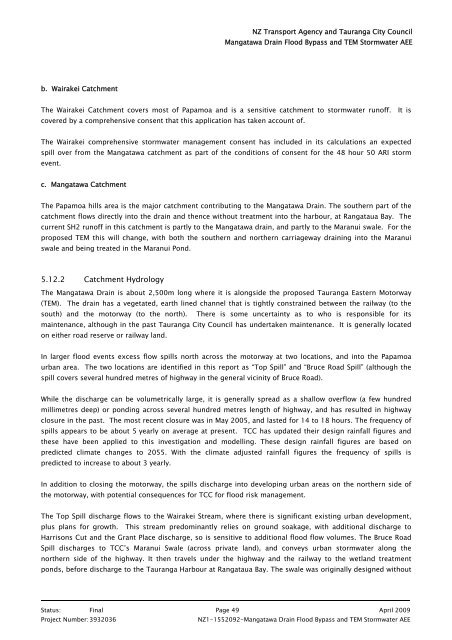2. Mangatawa catchment consents for earthworks, storm water ...
2. Mangatawa catchment consents for earthworks, storm water ...
2. Mangatawa catchment consents for earthworks, storm water ...
- No tags were found...
Create successful ePaper yourself
Turn your PDF publications into a flip-book with our unique Google optimized e-Paper software.
NZ Transport Agency and Tauranga City Council<br />
<strong>Mangatawa</strong> Drain Flood Bypass and TEM Storm<strong>water</strong> AEE<br />
b. Wairakei Catchment<br />
The Wairakei Catchment covers most of Papamoa and is a sensitive <strong>catchment</strong> to <strong>storm</strong><strong>water</strong> runoff. It is<br />
covered by a comprehensive consent that this application has taken account of.<br />
The Wairakei comprehensive <strong>storm</strong><strong>water</strong> management consent has included in its calculations an expected<br />
spill over from the <strong>Mangatawa</strong> <strong>catchment</strong> as part of the conditions of consent <strong>for</strong> the 48 hour 50 ARI <strong>storm</strong><br />
event.<br />
c. <strong>Mangatawa</strong> Catchment<br />
The Papamoa hills area is the major <strong>catchment</strong> contributing to the <strong>Mangatawa</strong> Drain. The southern part of the<br />
<strong>catchment</strong> flows directly into the drain and thence without treatment into the harbour, at Rangataua Bay. The<br />
current SH2 runoff in this <strong>catchment</strong> is partly to the <strong>Mangatawa</strong> drain, and partly to the Maranui swale. For the<br />
proposed TEM this will change, with both the southern and northern carriageway draining into the Maranui<br />
swale and being treated in the Maranui Pond.<br />
5.1<strong>2.</strong>2 Catchment Hydrology<br />
The <strong>Mangatawa</strong> Drain is about 2,500m long where it is alongside the proposed Tauranga Eastern Motorway<br />
(TEM). The drain has a vegetated, earth lined channel that is tightly constrained between the railway (to the<br />
south) and the motorway (to the north). There is some uncertainty as to who is responsible <strong>for</strong> its<br />
maintenance, although in the past Tauranga City Council has undertaken maintenance. It is generally located<br />
on either road reserve or railway land.<br />
In larger flood events excess flow spills north across the motorway at two locations, and into the Papamoa<br />
urban area. The two locations are identified in this report as “Top Spill” and “Bruce Road Spill” (although the<br />
spill covers several hundred metres of highway in the general vicinity of Bruce Road).<br />
While the discharge can be volumetrically large, it is generally spread as a shallow overflow (a few hundred<br />
millimetres deep) or ponding across several hundred metres length of highway, and has resulted in highway<br />
closure in the past. The most recent closure was in May 2005, and lasted <strong>for</strong> 14 to 18 hours. The frequency of<br />
spills appears to be about 5 yearly on average at present. TCC has updated their design rainfall figures and<br />
these have been applied to this investigation and modelling. These design rainfall figures are based on<br />
predicted climate changes to 2055. With the climate adjusted rainfall figures the frequency of spills is<br />
predicted to increase to about 3 yearly.<br />
In addition to closing the motorway, the spills discharge into developing urban areas on the northern side of<br />
the motorway, with potential consequences <strong>for</strong> TCC <strong>for</strong> flood risk management.<br />
The Top Spill discharge flows to the Wairakei Stream, where there is significant existing urban development,<br />
plus plans <strong>for</strong> growth. This stream predominantly relies on ground soakage, with additional discharge to<br />
Harrisons Cut and the Grant Place discharge, so is sensitive to additional flood flow volumes. The Bruce Road<br />
Spill discharges to TCC’s Maranui Swale (across private land), and conveys urban <strong>storm</strong><strong>water</strong> along the<br />
northern side of the highway. It then travels under the highway and the railway to the wetland treatment<br />
ponds, be<strong>for</strong>e discharge to the Tauranga Harbour at Rangataua Bay. The swale was originally designed without<br />
Status: Final Page 49 April 2009<br />
Project Number: 3932036<br />
NZ1-1552092-<strong>Mangatawa</strong> Drain Flood Bypass and TEM Storm<strong>water</strong> AEE
















